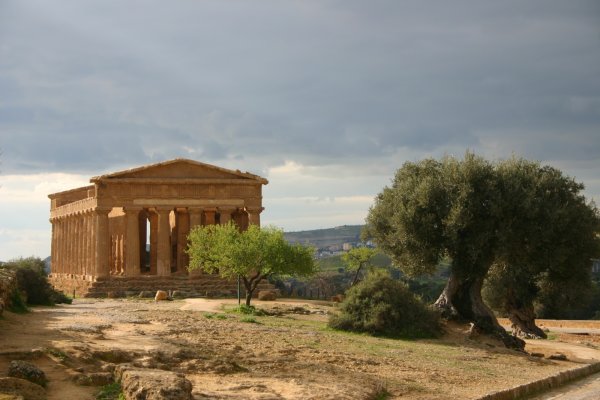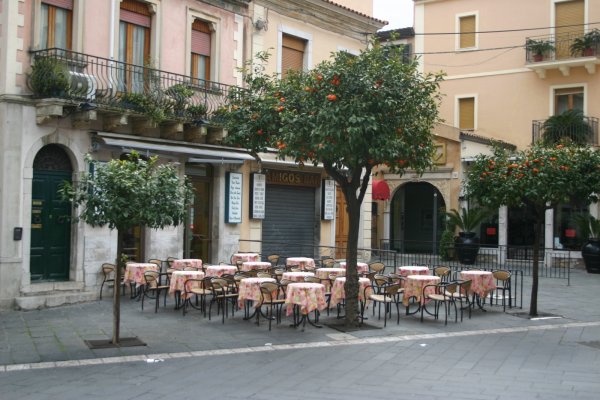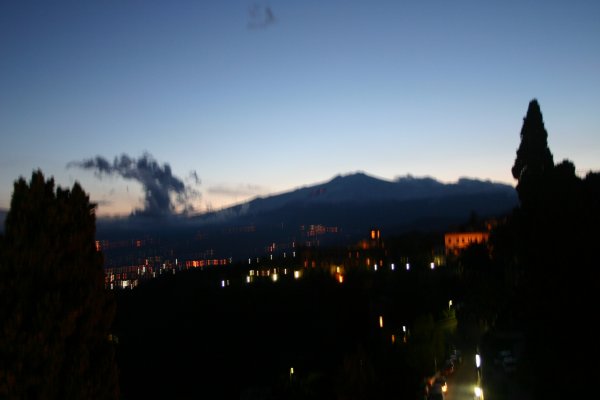- Joined
- Apr 14, 2006
- Messages
- 23,111
Now that a few people have asked me about it, I guess it is time to write of my February trip to Sicily. As far as the basic schedule and logistics – we flew from NYC on a Saturday evening, changed planes in Rome and arrived in Palermo late Sunday morning. We rented a car and drove around Sicily for the week, flying back to New York on Saturday.
Sicily is quite beautiful and incredibly interesting. The culture, the cuisine, the local language, the architecture and even the very land itself bear the heritage of the various peoples who have called it home over the past 3000 years. Invaded by the Greeks, Romans, Carthaginians, Arabs, Norman French, and Spanish, it is a place that has managed to assimilate them all into a unique mélange that I found very pleasing.
The island was surprisingly mountainous, with snow covered peaks towering over the airport and the seaside plain on which Palermo is built. The people seemed to congregate in the cities, where they lived for the most part in apartment buildings. I did not notice suburbs of single family houses such as we have in the US. Except for the highest and steepest peaks, it seemed that every bit of land outside the cities was under cultivation. There were olive groves, orange groves, almond trees, date palms, cactus plantations, vineyards, fields of winter wheat, and truck farms. If something can be cultivated, they probably grow it in Sicily. Needless to say, when combined with the fish from the Mediterranean Sea surrounding it, this abundance makes mealtimes a true joy. And on many of the high peaks, where nothing is grown, there are gigantic white wind turbines.
Palermo, the capitol, is a prime example of the blending of various cultures over the years. There are the great castles and plain stone churches built by the Normans, standing side by side with former mosques and 17th Century Spanish Baroque cathedrals, with the occasional modern building thrown in for good measure. During WWII, the city was bombed by both sides and some of the buildings, especially down the side streets and back alleys, bear the scars to this day. And through all this grand mix of architectural styles rush 600,000 Sicilians on scooters and in tiny cars, all driving at breakneck speed and with scant regard for the few traffic signals that do exist. (I will save my driving story for another post).
Outside of Palermo, one gets an even greater sense of the history of the island. Driving through the countryside, we saw bits of old castles and fortresses, old farmhouses and manors. It was interesting to try to guess the age of some of the structures we saw. Some of those stone buildings in the middle of a field could be a few hundred years old, or a few thousand.
My personal favorite spot was the Valle dei Templi (Valley of the Temples) in Agrigento, which has the best classical Greek ruins outside of Greece itself. Notwithstanding the name, it is not really a valley, but a stony ridge overlooking the sea, upon which the Greeks founded the city of Akagras some 2600 years ago. At some point, the residents all moved inland and further uphill, leaving a row of ancient stone temples standing in splendid isolation in the midst of olive and almond trees, where they glow orange in the afternoon light. Below is one of my favorite pictures -- of the Tempio della Concordia. I could swear the gnarled olive tree on the right is every bit as ancient as the temple.
We also spent a day in Siracusa, which was founded by the Greeks in 732 BC (I think). It too bears the mark of all the different people who have lived there. One of my favorite sights there was the Duomo (the cathedral) in the middle of the oldest part of town. Once you pass through the ornate Baroque façade into the sanctuary, you can see that it was engrafted directly onto the ancient Greek temple of Athena that stood there. The columns that separate the central nave and the side aisles and chapels are the original Greek temple columns. On one of the side streets outside, you can see the traditional three step crepidoma (temple base) below the 17th century wall. It is certainly an odd human trait that we all insist on having our holy buildings on the same spot.
The day of our 25th anniversary was spent in Taormina. Another ancient Greek town, built on a mountain spur with spectacular views of Mt. Etna and down the east coast of Sicily, it has been a popular European resort spot for nearly 200 years. The current town has a mediaeval feel to it, with very, very narrow stone paved streets between ancient buildings (in all of which, I must note, are high end clothing stores, expensive souvenir stores and the like, all catering to the tourists – in that respect, it reminded me of Camden, Maine). One special experience was sitting in our darkened room after dinner, watching the lava flow down the side of Mt. Etna.
My young wife’s favorite sight was the catacomb at the Convento dei Cappucini, which was featured in February’s National Geographic article on the mummies of Sicily. We didn’t take any pictures, but you can see some from the article here. Sicily Crypts — National Geographic Magazine
I am proud of the fact that during the entire trip I spoke English to no one but my wife. The one exception was our last day, when we had a private tour of some gardens in Palermo. My wife insisted that the guide and I speak English so she could understand us.
Sicily is quite beautiful and incredibly interesting. The culture, the cuisine, the local language, the architecture and even the very land itself bear the heritage of the various peoples who have called it home over the past 3000 years. Invaded by the Greeks, Romans, Carthaginians, Arabs, Norman French, and Spanish, it is a place that has managed to assimilate them all into a unique mélange that I found very pleasing.
The island was surprisingly mountainous, with snow covered peaks towering over the airport and the seaside plain on which Palermo is built. The people seemed to congregate in the cities, where they lived for the most part in apartment buildings. I did not notice suburbs of single family houses such as we have in the US. Except for the highest and steepest peaks, it seemed that every bit of land outside the cities was under cultivation. There were olive groves, orange groves, almond trees, date palms, cactus plantations, vineyards, fields of winter wheat, and truck farms. If something can be cultivated, they probably grow it in Sicily. Needless to say, when combined with the fish from the Mediterranean Sea surrounding it, this abundance makes mealtimes a true joy. And on many of the high peaks, where nothing is grown, there are gigantic white wind turbines.
Palermo, the capitol, is a prime example of the blending of various cultures over the years. There are the great castles and plain stone churches built by the Normans, standing side by side with former mosques and 17th Century Spanish Baroque cathedrals, with the occasional modern building thrown in for good measure. During WWII, the city was bombed by both sides and some of the buildings, especially down the side streets and back alleys, bear the scars to this day. And through all this grand mix of architectural styles rush 600,000 Sicilians on scooters and in tiny cars, all driving at breakneck speed and with scant regard for the few traffic signals that do exist. (I will save my driving story for another post).
Outside of Palermo, one gets an even greater sense of the history of the island. Driving through the countryside, we saw bits of old castles and fortresses, old farmhouses and manors. It was interesting to try to guess the age of some of the structures we saw. Some of those stone buildings in the middle of a field could be a few hundred years old, or a few thousand.
My personal favorite spot was the Valle dei Templi (Valley of the Temples) in Agrigento, which has the best classical Greek ruins outside of Greece itself. Notwithstanding the name, it is not really a valley, but a stony ridge overlooking the sea, upon which the Greeks founded the city of Akagras some 2600 years ago. At some point, the residents all moved inland and further uphill, leaving a row of ancient stone temples standing in splendid isolation in the midst of olive and almond trees, where they glow orange in the afternoon light. Below is one of my favorite pictures -- of the Tempio della Concordia. I could swear the gnarled olive tree on the right is every bit as ancient as the temple.
We also spent a day in Siracusa, which was founded by the Greeks in 732 BC (I think). It too bears the mark of all the different people who have lived there. One of my favorite sights there was the Duomo (the cathedral) in the middle of the oldest part of town. Once you pass through the ornate Baroque façade into the sanctuary, you can see that it was engrafted directly onto the ancient Greek temple of Athena that stood there. The columns that separate the central nave and the side aisles and chapels are the original Greek temple columns. On one of the side streets outside, you can see the traditional three step crepidoma (temple base) below the 17th century wall. It is certainly an odd human trait that we all insist on having our holy buildings on the same spot.
The day of our 25th anniversary was spent in Taormina. Another ancient Greek town, built on a mountain spur with spectacular views of Mt. Etna and down the east coast of Sicily, it has been a popular European resort spot for nearly 200 years. The current town has a mediaeval feel to it, with very, very narrow stone paved streets between ancient buildings (in all of which, I must note, are high end clothing stores, expensive souvenir stores and the like, all catering to the tourists – in that respect, it reminded me of Camden, Maine). One special experience was sitting in our darkened room after dinner, watching the lava flow down the side of Mt. Etna.
My young wife’s favorite sight was the catacomb at the Convento dei Cappucini, which was featured in February’s National Geographic article on the mummies of Sicily. We didn’t take any pictures, but you can see some from the article here. Sicily Crypts — National Geographic Magazine
I am proud of the fact that during the entire trip I spoke English to no one but my wife. The one exception was our last day, when we had a private tour of some gardens in Palermo. My wife insisted that the guide and I speak English so she could understand us.




 If the economy improves and my portfolio squeezes out a few additional bucks, I'm going to go there.
If the economy improves and my portfolio squeezes out a few additional bucks, I'm going to go there.